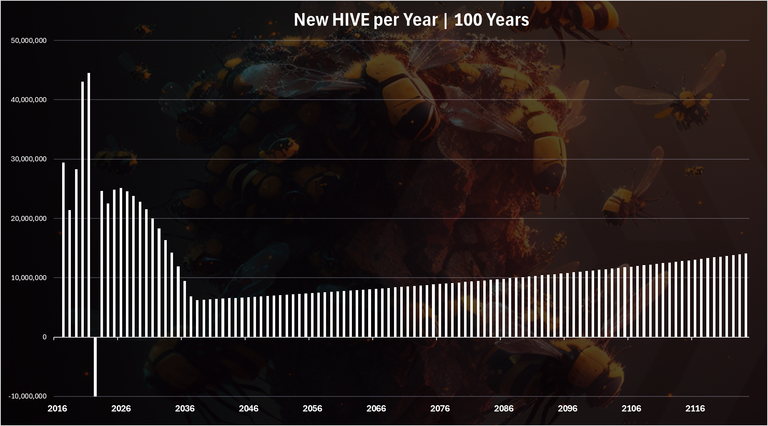I haven't seen such a post in a good while. Believe it or not, there are people on Hive who don't know they can earn rewards by curating content, for example.
Let's try to unveil some of the secrets.
A predetermined amount of HIVE is created every day (every block if we want to be precise) based on rules that are embedded at the core of the blockchain (and can only be changed through a hard fork).
@dalz even made a projection of how the HIVE inflation will evolve yearly for the next 100 years, if nothing changes. Here's his chart:

Note the sharp decline in the projected inflation till around 2036, and the slow increase thereafter in raw numbers.
Also note, from this year forward is projected inflation, not realized one. When reality meets projection, something like the negative inflation (deflation) we had in 2022 can happen or much higher than projected inflation we had in 2020 and 2021.
The way to adjust inflation is through conversions (HIVE -> HBD burns HIVE and creates HBD, HBD -> HIVE burns HBD and creates HIVE) or direct burning of HIVE (sending HIVE to @null or setting @null as a beneficiary of author rewards).
The inflation @dalz projected up there is the one based on HIVE. There is an additional inflationary component introduced by the HBD interest payments that isn't counted. Its effects can be observed and tracked in time, but projections can't be made because the amounts of HBD moving in or out of savings cannot be projected.
Warning signs can be observed by tracking the debt ratio. If it lowers, it's great! If it moves toward 30% (the haircut level), we should get ready for author rewards in HBD to slowly drift to HIVE and finally stop completely until the debt ratio returns below 30%. All rewards in HBD would stop at 30% debt ratio, including interest on HBD in savings. I'm not sure how DHF payments are handled in this situation. Normally, they are paid in HBD, the likely scenario is they would get paid in HIVE after that. Right now, at 8.9%, while it increased a bit due to the drop in the price of HIVE compared to HBD, it is under control.
How Is Hive Inflation Distributed?
Here's the breakdown:
- Reward Pool: 65%
- Staking rewards: 15%
- DHF: 10%
- Witnesses: 10%
Staking Rewards
I bet you didn't know about this one, did you? 😀 Well, if you've been on Hive for a long time, you probably know about it.
These rewards are self-explanatory. Own a HIVE stake (i.e. HIVE Power) and receive these rewards. They are currently offering around 3.18% APR (without doing anything else, like curating), but they are fluctuating.
In the past, there was a little app that one could use to watch how staking rewards accumulate (usually on a big account).
I don't think that app is around, but you can go to an account like... blocktrades, on the wallet page. Look at his HIVE Power. Now close your mouth. Wait for a few seconds. Hit refresh. Look again! Magic, huh? You can repeat a couple of times just for fun. Note that there is no transaction dropping these staking rewards every 3 seconds (or less often if they are too low). They just "show up" and accumulate in your HP.
It's easier to observe that within a couple of minutes on a huge account, but the same happens for any account holding HIVE Power.
DHF (Decentralized Hive Fund)
The DHF is quite... wealthy. The 10% it receives through inflation is not its only source of revenue. It was also funded with the former "ninja mine" from st**mit, which I think was around 80m HIVE that is now slowly being converted to HBD in the DHF. Beneficiary rewards to DHF are also a common occurrence.
The DHF is used to fund various Hive-related projects, usually development, infrastructure, or marketing. so far.
Have you ever checked the DHF proposals? There are different interfaces from where to see them, here's one of them.
Witness Rewards
It makes sense to incentivize people who secure the Hive blockchain and maintain the core and public infrastructure that allows the ecosystem to work. Many witnesses are also developers and have certain projects they work on for Hive. Others (fewer) are business owners on Hive, or community developers.
They receive witness rewards when they produce new blocks. Consensus witnesses (Top 20) produce more blocks than the rest of witnesses because they are part of every rotation, therefore they'll receive more rewards. Top 21 and below are called backup witnesses and they are being added as the 21st witness in every rotation, based on how high on the ranking they are. If they are higher, they will be in rotation more often than the witnesses at the bottom of the hierarchy.
Together with the DHF, they form the governance on Hive. Your owned HIVE Power allows you to influence governance decisions, on DHF proposals as we discussed above, and on witness ranking.
Reward Pool
Most users would be interested in the reward pool. It is the highest, percentage-wise, but also there is the most competition for those 65% because most users on Hive are interested in these rewards, provided they know about them.
There is a strong possibility that enough users don't know about them, especially if they came to Hive as gamers, not as content creators.
In the paragraph above I already used a common misconception: that you need to be a content creator to have a share of the reward pool.
That's false! There are large stakeholders, some of them coming much later and buying their stake, and who don't create content or rarely do. But they curate (meaning to vote on posts and comments).
That 65% of inflation that goes to the reward pool every day is split 50/50% between authors and curators. The author rewards themselves can be distributed in various ways depending on the options of the author.
It can be paid out fully as HP, split equally between HBD and HP, or with additional beneficiaries who receive a set portion of the author rewards. Two promoted beneficiaries of rewards are @hive.fund (DHF) or @null (author rewards are burned). Note that setting beneficiary to @null is different than declining rewards, which is another option authors have. Sending beneficiary rewards to @null only burns author rewards, but curators earn their share of rewards. Decline rewards means that any amount of rewards associated with a post, both for author and curators, are sent back to the reward pool at payout.
You may note that top earners on Hive earn much more from curation than from author rewards, and none of the top rewarded authors are in this top. That makes sense to some degree, because having top authors earning much more from inflation than currently means less for smaller authors, which will get demotivated. I don't think Hive can attract large influencers with author rewards, but there are ways to boost their gains, and, when they'll be created and improved on Hive, these content creators along with their communities may look at our ecosystem with different eyes.
For small-to-medium or first-time content creators, Hive can be incredible, if they have the patience to stick around until they start seeing some more consistent rewards.
But once again, do not disregard curation! Learn to use it right, don't waste your votes where chances are you won't receive any rewards (nor will the author you vote for), and ask where you don't understand.
And here are some useful remarks we seem to be making every time there is a slowdown of content creation on Hive.
The reward pool is more or less equal in size every day, on the short term. If, all of a sudden or gradually, the content creation drops in half (I gave a random ratio, but the drop in new content is visible lately on Hive), that means the remaining posts share a higher slice of the pool because the entire pool is distributed every time, with the exception of certain rewards being burned or declined.
It also means the curators must be looking for something to vote on to consume their voting power. Since there is less content, it's more likely they will find your posts, if you stay active.
If this period is also accompanied by a drop in the number of curators (although that is rarely the case, even if many votes are automated), the remaining curators decide how the reward pool is distributed.
Before I wrap up this section, I want to add a little interesting information regarding the distribution of author rewards between HBD and HP, with a 50/50% option selected. It's interesting that this is not truly 50/50%, as @demotruk remarked.
Looks like authors earn more HBD and less HP when HBD is over the peg and less HBD and more HP when HBD is below the peg. HBD is usually below the peg, even by a small fraction. Since curators rewards are paid entirely in HP, that means most of the times they receive a little above 50%. If author rewards are paid 100% in HP, then the 50/50% split between author and curators rewards holds at all times (at least I think so), but the author loses the flexibility of liquid rewards.
Posted Using InLeo Alpha
